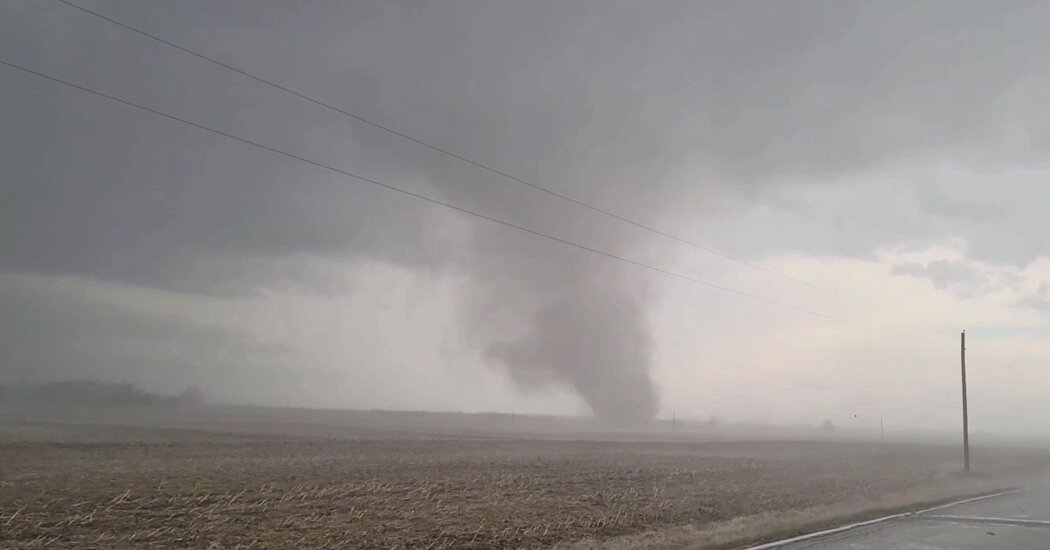An expansive and volatile weather system that lashed parts of the Midwest with thunderstorms, hail and snow on Tuesday was still threatening residents across several states on Wednesday morning.
The bad weather was expected to continue well into the day, potentially bringing severe storms within a broad region of the central United States that stretches from Memphis to southern Michigan, the National Weather Service said in a forecast.
A tornado watch was in effect until 9 a.m. on Wednesday for more than two million residents across parts of Arkansas, Illinois and Missouri, meaning that conditions in and around that area were favorable for both tornadoes and severe thunderstorms. Nearly six million others in parts of Iowa, Missouri and Oklahoma were also under a severe thunderstorm watch through much of the morning.
Justin Gibbs, a meteorologist with the Weather Service in Paducah, Ky., said early Wednesday that at least one tornado had touched down overnight in Bollinger County, in southeast Missouri.
Mr. Gibbs said there was “quite a bit of damage,” but it was unclear if there were any injuries. “The radar signature suggests that it was a potentially pretty strong tornado,” he said, adding that a survey team will be in the area to evaluate the scene after sunrise.
And in the Upper Plains and Rockies, heavy snow was falling and several major roads were closed early Wednesday, as drivers faced poor visibility and other hazards. More than a million people were under blizzard warnings, and the Weather Service said that several inches were likely to fall in parts of North Dakota and Minnesota by the evening.
The central United States has had a run of bad weather recently, including destructive tornadoes and blizzards that hammered the region last week.
On Tuesday, several fresh tornadoes were reported in Iowa, Missouri and Illinois.
In Colona, Ill., about 80 miles southeast of Cedar Rapids, Iowa, a tornado ripped the roof from a gas station and uprooted trees, according to the service. The local police said that two people had been evacuated safely from the station, and that no injuries were reported.
In Iowa, the storms rumbled near areas where tornadoes had torn roofs off homes and other buildings days earlier, displacing residents.
One of those residents, Jacob Dilks of Hills, Iowa, said he had been on an “emotional roller coaster” ever since his home was destroyed last Friday. On Saturday, his son turned 2. On Tuesday, his wife gave birth to a girl.
“One minute, you’re scared for the lives of your family, and the next you’re happy to be alive,” said Mr. Dilks, 28, whose family has been staying with relatives in nearby Coralville.
Destructive, baseball-size hail was also reported on Tuesday afternoon in towns in northeast Illinois. The roughly three-inch hail that fell in the Chicago area was the largest since a July 2020 storm, according to the National Weather Service in Chicago. The Chicago Fire Department said that high winds had downed trees and power lines, and damaged buildings.
In Chicago, where voters on Tuesday elected Brandon Johnson as mayor, people appeared to heed a call to vote early, ahead of bad weather, according to Max Bever, a spokesman for the Chicago Board of Elections. As of noon local time, the number of ballots cast reflected a 23 percent citywide turnout, compared with 21 percent at noon in the previous election on Feb. 28.
Aside from a dip in voter turnout in the early afternoon as a thunderstorm rolled through, the board was not aware of other storm-related effects on turnout, Mr. Bever said on Tuesday night. He added that the overall turnout figure for the day was relatively low for an election day.
As night fell across the central United States on Tuesday, officials were cautioning residents to prepare for a new set of dangers.
“The danger of a rain-shrouded tornado in the dark is significantly higher than it is during the daytime hours, when everybody’s out and about, paying attention,” said Jon Green, a supervisor for Johnson County, Iowa, parts of which were slammed days ago by violent weather. A 24-unit building in Coralville, about 20 miles south of Cedar Rapids, was rendered uninhabitable, Mr. Green said.
Much of the tornado risk early Wednesday is concentrated over Arkansas, where five people died in separate tornadoes last Friday. Forecasters said on Tuesday night that they were monitoring a potential tornado threat over an area including Little Rock, the capital.
Scientists are not yet able to determine whether there is a link between climate change and the frequency or strength of tornadoes. Researchers do say that in recent years tornadoes seem to be occurring in greater clusters, and that the region known as tornado alley in the Great Plains, where most tornadoes occur, appears to be shifting eastward.
Cindy Hadish, Johnny Diaz, Mike Ives and Derrick Bryson Taylor contributed reporting.

